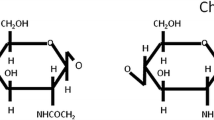Abstract
Hide collagen of animals is used to prepare adsorbent material and its adsorption properties to tannins are investigated. It is indicated that the collagen fibres has excellent adsorption selectivity and high adsorption capacity to tannins. The adsorption rate of tannins is more than 90% whilst less than 10% of functional components are retained by the adsorbent. The adsorption mechanism of tannins onto hide collagen fibres is hydrogen-bonding association. Freundlich model can be used to describe the adsorption isotherms, and the pseudo-second-order rate model can be used to describe adsorption kinetics.
Similar content being viewed by others
References
Shi, B., Di, Y., Plant Polyphenols (in Chinese), Beijing: Science Press, 2000, 5–18, 73–91.
Hu, G. S., The study of the method of removing tannins from traditional Chinese medicine, Chinese Herbal Medicine (in Chinese), 1991, 22(11): 491–493.
Xu, M. C., Wang, C. R., Xu, M. C. et al., Adsorption of tannin from aqueous solution onto macroporous crosslinked poly(N-vinyl-acetamide) via hydrogen bonding, Chinese J. of Reactive Polymers, 2000, 9(1): 23–28.
Wang, J., Xu, Z. S., Mao, H. L., The investigation of the method to remove tannins from injection of traditional Chinese medicine, J. of Traditional Chinese Medicine of Basal Layer (in Chinese), 2001, 15(5): 51–52.
Li, J., Li, J., Shu, X. J., The approach study of removing impurity from extract of the ginkgo leaf, Chemical World (in Chinese), 1998, 39(5): 243–247.
Lu, Y., Bennick, A., Interaction of tannin with human salivary proline-rich proteins, Archives of Oral Biology, 1998, 43: 717–728.
Mitjavila, S., Lacombe, C., Carrera, G. et al., Tannic acid and oxidized tannic acid on the functional state of rat intestinal epithelium, J. Nutr., 1977, 107: 2113–2121.
Buso, A., BalBo, L., Giomo, M., Electrochemical removal of tannins from aqueous solution, Ind. Eng. Chem. Res., 2000, 39: 494–499.
Sun, D. W., Chemistry of Vegetable Tannins (in Chinese), Beijing: Forestry Press of China, 1992, 1, 257.
Shi, B., He, X. Q., Haslam, E., Polyphenol-gelatin interaction, J. Amer. Leather Chemist. Assoc., 1994, 89(4): 98–104.
Li, J. Z., Sun, J. X., Shi, Z. Q., Hydrogen bonding adsorption and its prospect, Ion Exchange and Adsorption (in Chinese), 2001, 17(6): 561–566.
Lu, X. Y., A brief discussion on manufacture of hide powder for tannin analysis, Chemistry and Industry of Forest Products (in Chinese), 2000, 20(1): 71–74.
Tiwari, D., Mishra, S. P., Mishra, M. et al., Biosorptive behavior of Mango (Mangifera indica) and Neem (Azadirachta indica) bark for Hg2+, Cr3+ and Cd2+ toxic ions from aqueous solution: a radiotracer study, Applied Radiation and Isotopes, 1999, 50: 631–642.
Author information
Authors and Affiliations
Corresponding author
Rights and permissions
About this article
Cite this article
Liao, X., Lu, Z. & Shi, B. Selective adsorption of tannins onto hide collagen fibres. Sc. China Ser. B-Chem. 46, 495–504 (2003). https://doi.org/10.1360/02yb0206
Received:
Issue Date:
DOI: https://doi.org/10.1360/02yb0206




